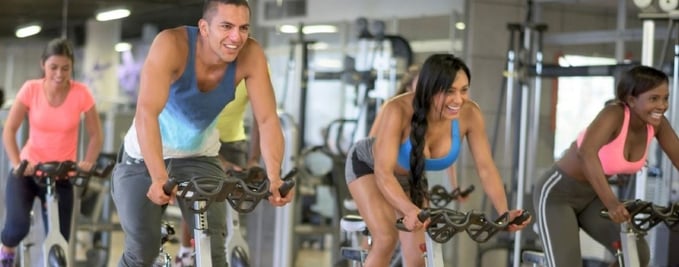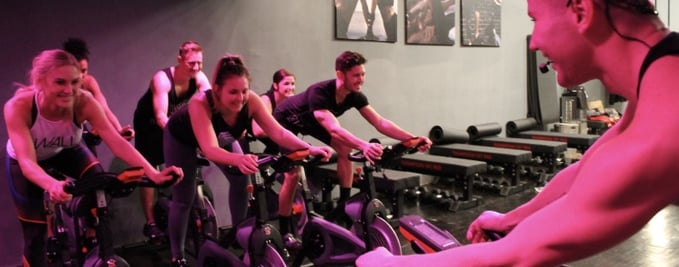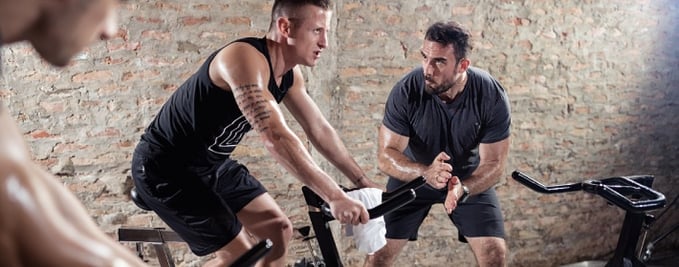Power vs Rhythm: The Debate is On!

Pioneers!
With the rise of power meters being used indoors, our indoor cycling world seems to have become hyper-divided between power-purist studios and rhythm-based studios. In the interest of filling classes, however, we think it is important to explain how and why each format (Power and Rhythm) is important and how we can find a happy medium to blend them.
What is the primary difference between Power-based and Rhythm-based indoor cycling classes?
- A Power based class focuses predominantly on performance based techniques; this includes using metrics (data) on a display unit (console in the indoor cycling world) and possibly collecting said data to build training protocols.
- A Rhythm based class focuses largely on the beat of the music; this usually includes higher energy songs with build ups and clear beat drops. Consoles may be used but mainly for the purpose of setting time expectations and monitoring RPM. Many studios still do not use consoles, but we are noticing this starting to change.

What are some benefits of Power-based indoor cycling?
A focus on quantifying work (Hunter Allen Power Blog): “Data”, such as watts (the power metric) or Kilojoules (watts accumulated over time) to identify a level of intensity for each segment of work performed. This work can then be measured to determine how much stress the rider has endured over the course of the workout, or over longer periods of time. This type of analytical evaluation allows the rider to zero in on the areas of lower level fitness, optimizing his/her lower end and higher end cardiovascular zones while monitoring proper recovery.
Using a power meter and console is much like having a personal trainer guiding and motivating you through your workout. Your personal trainer will tell you when you “backed off” on intensity or will give you the needed information to avoid peaking your performance too early. Additionally, using the metrics on the console, regardless of your overall intent in participating in the class, allows you see whether you are following the instructed prompts for more or less intensity, whether you are staying consistent in your pedal stroke turnover and body position, and for the purpose of pacing.

What are some benefits of Rhythm-based indoor cycling?
Riding with the rhythm of the music is when the rider hits the front push of the pedal stroke on the down beat of the song. If we imagine the pedal stroke from the top all the way around resembles a clock, most of our work comes between 12 & 4. This is also the area where your foot is on the downbeat of the music. So if that’s true, then we really need to either feel the music or know the beats per minute (BPM) of the song, leading us to know our revolutions per minute (which many bike consoles display as RPM).
How can BPM’s and RPM’s Be Used During Ride Design?
The beats per minute of a song gives instructors a good place to start their ride design. There are lots of apps that will tell you the beat of the music. You can open an app, tap your finger to the beat of the music and the screen will show you what the bpm’s are…like a metronome. Once you have this number, you know that one foot will hit the front push on one beat and the other foot will hit the front push on the very next beat. Because revolutions per minute is how many times ONE leg goes around the full revolution in one minute, then we know we cut the BPM’s in half in order to know our RPM’s.
What Are Safe RPM Ranges?
Collaboratively indoor cycling groups have identified a series of safe RPM ranges for riders. For higher resistances, RPMs can range from 60 – 80, where in workout segments with less resistance, the RPM range varies anywhere between 80 – 115. That’s not to say you can never go outside of those numbers, but we must have a specific purpose to do so, as our risk of injury can increase and we can also completely lose effectiveness…and since we’re giving up an hour on a bike that goes nowhere, most of us would like to get the biggest bang for our buck!

What Do We Know About Riders’ Class Expectations?
- They want to participate in a class that has a purpose.
- They want to feel some form of assurance of safety.
- They want to leave feeling like he/she worked out.
- Instructors/coaches are their primary motivator to ensure they come back.
- They need to leave feeling invigorated and not just exhausted.
come away having achieved all of the above!

The Power vs Rhythm Debate Can Be Hot!
We all see the debates between Power Purists and Rhythm Riders on social media and
in discussions. Rather than debating, though, we as instructors have an opportunity to
keep an open mind and learn from each other. Ask questions rather than jump to
conclusions. Think critically and realize opportunity. Because….
The Reality Is…
- We need each other! Why always reinvent profiles? Why not accept what other
people have to offer and simply edit the content to define it as your own? Most
professionals in this industry do not get paid to prepare for their classes. So
poach away! (Give kudos to the creator of course!) - Variety is key. Offering a plethora of ride protocols allows for clients to experience both lower end cardiovascular training as well as higher interval based efforts. Remember, your clients will only be able to perform those higher bouts of efforts when they have been supported with lower end base training and recovery.
- Variety in coaching, even in one hour-long class, can be exciting to participants, keep them on their toes, expose them to different ways of reaching their cardiovascular zones, and just be plain ol’ fun! Try a class that has some time-based goal riding, high intensity intervals, and songs where you hang out in steady state where you can use the rhythm for consistency and still create a ‘party’ like atmosphere.
- Power AND Rhythm classes have benefits and can be combined successfully. When they are combined, you may be pleasantly surprised to see your classes fill up, and ideally, you’ll access additional different types of riders!
We hope this has proven to be of some value to you and we look forward to sharing
more indoor cycling content in the future!
Take Care Everyone!
Kristy Kilcup and Marina Mitchell
Stages Indoor Cycling Master Educators
Related Content:
Empower your staff and reassure your community with our FREE downloadable cleaning and disinfecting guides for fitness centers, educational settings, hospitality facilities and more.
Topics from this blog: Training Tips
Back


